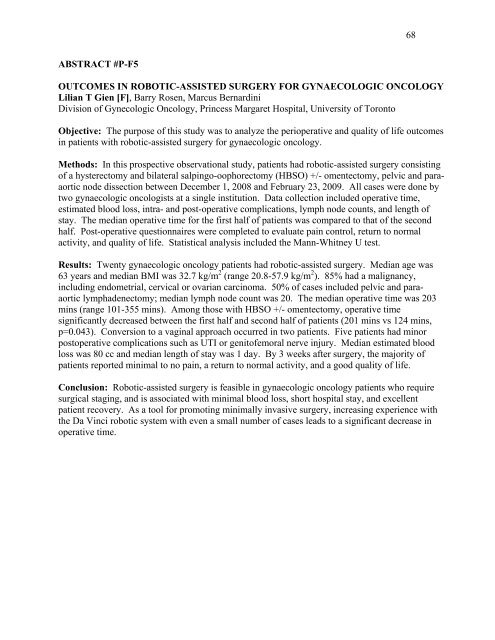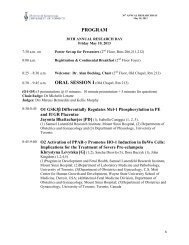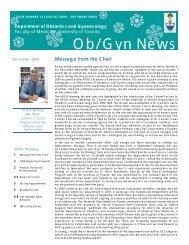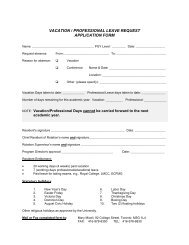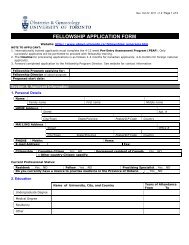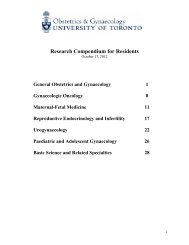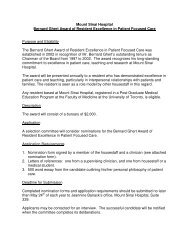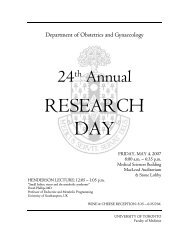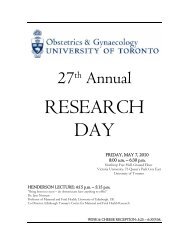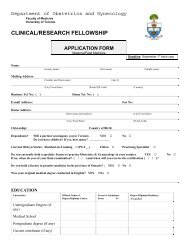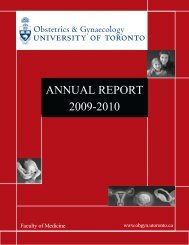research day - University of Toronto Department of Obstetrics and ...
research day - University of Toronto Department of Obstetrics and ...
research day - University of Toronto Department of Obstetrics and ...
Create successful ePaper yourself
Turn your PDF publications into a flip-book with our unique Google optimized e-Paper software.
68<br />
ABSTRACT #P-F5<br />
OUTCOMES IN ROBOTIC-ASSISTED SURGERY FOR GYNAECOLOGIC ONCOLOGY<br />
Lilian T Gien [F], Barry Rosen, Marcus Bernardini<br />
Division <strong>of</strong> Gynecologic Oncology, Princess Margaret Hospital, <strong>University</strong> <strong>of</strong> <strong>Toronto</strong><br />
Objective: The purpose <strong>of</strong> this study was to analyze the perioperative <strong>and</strong> quality <strong>of</strong> life outcomes<br />
in patients with robotic-assisted surgery for gynaecologic oncology.<br />
Methods: In this prospective observational study, patients had robotic-assisted surgery consisting<br />
<strong>of</strong> a hysterectomy <strong>and</strong> bilateral salpingo-oophorectomy (HBSO) +/- omentectomy, pelvic <strong>and</strong> paraaortic<br />
node dissection between December 1, 2008 <strong>and</strong> February 23, 2009. All cases were done by<br />
two gynaecologic oncologists at a single institution. Data collection included operative time,<br />
estimated blood loss, intra- <strong>and</strong> post-operative complications, lymph node counts, <strong>and</strong> length <strong>of</strong><br />
stay. The median operative time for the first half <strong>of</strong> patients was compared to that <strong>of</strong> the second<br />
half. Post-operative questionnaires were completed to evaluate pain control, return to normal<br />
activity, <strong>and</strong> quality <strong>of</strong> life. Statistical analysis included the Mann-Whitney U test.<br />
Results: Twenty gynaecologic oncology patients had robotic-assisted surgery. Median age was<br />
63 years <strong>and</strong> median BMI was 32.7 kg/m 2 (range 20.8-57.9 kg/m 2 ). 85% had a malignancy,<br />
including endometrial, cervical or ovarian carcinoma. 50% <strong>of</strong> cases included pelvic <strong>and</strong> paraaortic<br />
lymphadenectomy; median lymph node count was 20. The median operative time was 203<br />
mins (range 101-355 mins). Among those with HBSO +/- omentectomy, operative time<br />
significantly decreased between the first half <strong>and</strong> second half <strong>of</strong> patients (201 mins vs 124 mins,<br />
p=0.043). Conversion to a vaginal approach occurred in two patients. Five patients had minor<br />
postoperative complications such as UTI or genit<strong>of</strong>emoral nerve injury. Median estimated blood<br />
loss was 80 cc <strong>and</strong> median length <strong>of</strong> stay was 1 <strong>day</strong>. By 3 weeks after surgery, the majority <strong>of</strong><br />
patients reported minimal to no pain, a return to normal activity, <strong>and</strong> a good quality <strong>of</strong> life.<br />
Conclusion: Robotic-assisted surgery is feasible in gynaecologic oncology patients who require<br />
surgical staging, <strong>and</strong> is associated with minimal blood loss, short hospital stay, <strong>and</strong> excellent<br />
patient recovery. As a tool for promoting minimally invasive surgery, increasing experience with<br />
the Da Vinci robotic system with even a small number <strong>of</strong> cases leads to a significant decrease in<br />
operative time.


